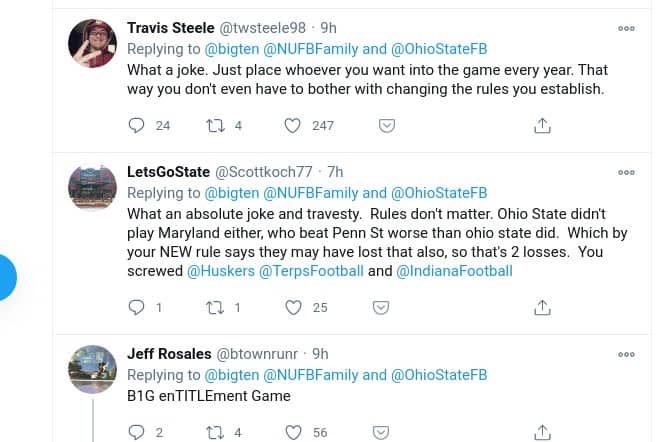
- The Big Ten has eliminated the six game minimum requirement and will allow Ohio State to play in the conference championship game.
- The move will pave the way for Ohio State to play for the National Championship.
- Ultimately, the conference ‘followed the money’ instead of the rules that they created prior to the season.
Any pretense that college athletics stand for something other than the almighty dollar ended today as the Big Ten retroactively changed a rule that would have kept Ohio State out of the conference championship game. The Buckeyes, you see, are set to bring far too much money to the Big Ten to expect them to live by the same set of standards as every other team in the conference.
ESPN tried to soft pedal what had happened–their headline informed the gentle reader that the Big Ten had simply made a ‘rule adjustment’.

In the story itself, the self proclaimed ‘worldwide leader’ characterized the decision as the Big Ten having ‘changed its policy’. Obviously, ESPN wasn’t going to come down hard on one of their broadcast partners so their soft pedaling this story is no huge shock.
Here’s what happened: this summer, the Big Ten announced a ‘conference only’ schedule. A few days later, they decided to cancel or at least postpone the season. In September, however, the Big Ten reversed course like a squirrel crossing a suburban road and decided to play after all. The schedule was created in order to facilitate a Big Ten team competing in the College Football Playoff as 247 Sports informed us at the time:
The Big Ten’s target date comes with strategy as ESPN’s Heather Dinich reports an eight- or nine-game season allows the conference to be eligible for the College Football Playoff.
When the Big Ten came up with their COVID-19 guidelines they had the unmitigated gall to suggest that many were done with ‘fairness’ in mind–here’s one that the Chicago Tribune reported at the time–the Big Ten stipulated that no team could sell tickets to the general public citing ‘safety and fairness’ (emphasis added):
Wisconsin is not even permitted to have family members of players and coaches at Camp Randall Stadium on Friday for their game against Illinois because of COVID spikes in the state, so the conference thought it fair that every team play by the same rules.
That was still apparently the ‘party line’ in late October when the Big Ten released tiebreaker rules governing cancelled games and the conference championship:
The Big Ten, which begins its season at 8 p.m. ET on Friday when No. 14 Wisconsin hosts Illinois, is attempting to play an eight-game conference season in eight weeks, plus a ninth game for all 14 teams during Big Ten champions week the weekend of Dec. 19. In order to compete in the Big Ten championship game, a team must play at least six games, according to conference tiebreaker rules that were also released on Thursday.
The entire justification for the elaborate tiebreaker rules was the very real possibility that a team could end up playing fewer than six games. The reason for this was obvious–it would be unfair to teams that managed to follow COVID-19 mitigation protocol and keep everyone healthy so that games could be played got screwed over for a spot in the Big Ten Championship by a team that had a better record playing a fewer number of games. That’s why a ‘line of demarcation’ was created by the conference and that ‘line’ was six games.
UNTIL IT WASN’T! Today, the Big Ten decided to change their rules so 5-0 Ohio State can advance to the conference championship game:
This part in particular is a bit of Nixonian level double-speak:
“The decision was based on a competitive analysis which determined that Ohio State would have advanced to the Big Ten Football Championship Game based on its undefeated record and head-to-head victory over Indiana regardless of a win or loss against Michigan.”
Yep–they definitely would have except that they *didn’t play enough games*. Ohio State had three games canceled due to COVID-19 this season. Comments on Twitter were not as kind to the Big Ten as was their broadcast partner ESPN:


This is basically my point. The Big Ten can put the teams they want in the conference championship game this year and every year. But if they’re going to take that route just be honest about it. Creating an elaborate framework of rules and protocol that every team knew in advance of the season only to throw them out the window to benefit Ohio State is hypocritical and disingenuous on a variety of different levels. Why not just say that touchdowns count for 10 points when Ohio State scores them? They could have just scheduled one game for Ohio State, let them rest and practice all year and then move them into the Big Ten Championship for beating, say, perennial conference whipping boy Rutgers. Actually, they *did* beat Rutgers. They also beat three other losing teams along with a 7 point win over 6-1 Indiana. That’s a combined record of 14-19 for Ohio State opponents.
Michigan athletic director Warde Manuel came up with this nonsensical justification of the rule switcheroo:
“I don’t believe that anybody at Ohio State or any other team should be punished for decisions that we made by looking at eight games and saying, ‘We should play six” not knowing the effects of what happens to them and their team versus what happens to our team.”
If I’m translating this bit of gibberish correctly…’no one should have to abide be rules if we as a conference don’t like the result of the rules that we ourselves established at the start of the season’.
Shannon Ryan explained it all in a column for the Chicago Tribune which she began with this salient observation:
Michigan and Ohio State have played each other in football every season since 1917 — until blasted 2020 broke the 103-year streak.
This once-in-a-lifetime cancellation should make fans realize playing sports in a pandemic is frivolous, not essential.
Michigan would have been missing double-digit starters and COVID-19 cases were increasing each day, according to Yahoo Sports. The Big Ten hasn’t been able to get through one week without a cancellation since opening weekend. More than 100 football games nationally have been canceled or postponed, now including “The Game.”
That’s the scenario that every team and conference in college football was (and is) up against. Every team has suffered. Perennial National Championship contender Clemson was forced to play Notre Dame without their starting quarterback Trevor Lawrence. By Ohio State’s standards, Clemson coach Dabo Swinney should petition the ACC to make the Tigers OT loss to the Irish without the best QB in college football not count for…’reasons’. But like every other team in college football–except, apparently, Ohio State–Clemson was aware of the risks and challenges of playing during a pandemic.
Ryan continues:
Compete at all costs. Amend rules on the fly. Pandemic? Oh, please.
The Big Ten put itself in a predictable bind by not leaving any open dates on the schedule for makeups and underestimating the number of games that would be canceled. It was foreseeable that at least a few teams wouldn’t reach the six-game threshold to compete in the conference title game.
Entering the final weekend of the eight-week regular season, Maryland and Wisconsin have played only four games. Ohio State and Minnesota have played five.
The Buckeyes’ Nov. 14 game was canceled because of COVID-19 cases within Maryland’s program, and they had to call off their Nov. 28 game at Illinois because of an outbreak in their program.
The move to allow Ohio State to play in the conference championship game was motivated by money as much as anything. The decision wasn’t a huge surprise.
she continues
No shocker: Ohio State coach Ryan Day pushed for special consideration.
“If we don’t quite get the games we need to get into the championship game, I think that needs to be looked at hard, just like anybody else in the conference,” he said.
Don’t get me wrong. Ohio State is the conference’s best team and deserves consideration for the College Football Playoff. The Big Ten realized its best chance to be represented in the playoff is Ohio State earning a resume-enhancing conference championship.
The Big Ten message was clear: Too bad for everyone else who played with the understanding of “the rules are the rules.”
Her conclusion:
Ohio State was one of the teams pushing for a return to football this fall, touting its chances for a national championship season. Those dreams were enhanced by persuading the Big Ten to make another hasty rule change.
In September, Ohio State was chanting along with other teams, “We want to play.” The Buckeyes got what they wanted.
Now the Buckeyes demanded, “Play by our rules.” And the Big Ten bent again.
It’s hard to blame Ohio State for making an appeal to the conference knowing that it would likely be successful. It’s also hard to blame the Big Ten as they knew that putting Ohio State in the Big Ten Championship game to enhance their resume for the College Football Playoff was the most lucrative course of action. The potential payoff will greatly benefit every school in the conference in a year where they need all the revenue they can get.
It all makes sense–it’s all about money. Nothing wrong with that, but try not to be so sleazy and duplicitous about it. I don’t expect much from college sports but they should at least try to run their operation with more integrity and competitive fairness than Vince McMahon runs the WWE.
So congratulations to Ohio State. Enjoy getting hammered by Clemson or Alabama…..









